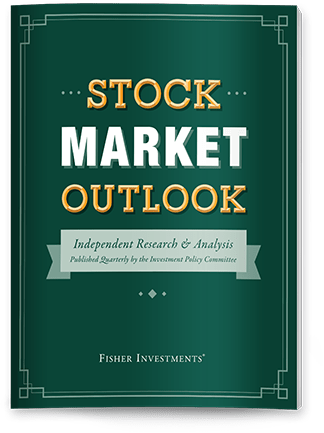Personal Wealth Management / Interesting Market History
Three Lessons From a Three-Year-Old Bull Market
Some takeaways from this toddler of a bull market.
Sunday, October 12, was a mini-milestone of sorts. The global bull market celebrated its third birthday—and we will commemorate the occasion by imparting three investment lessons from these three years.
Lesson One: Bull markets don’t need great news to begin.
Rewind three years ago. US and global stocks had broken through the -20% bear market threshold in mid-June. After a summertime rally, global stocks fell further, hitting their low on October 12 (-26.1% from January 4).[i]
History calls this a bear market, and rightfully so. Still, 2022’s downturn lacked some traditional bear market features. It didn’t start after euphoric sentiment blinded investors from deteriorating fundamentals (i.e., stocks didn’t run out of proverbial wall of worry). Neither did a large, little-noticed negative destroy trillions of dollars in global GDP (a wallop).
Rather, 2022 was the rare sentiment-driven bear market as multiple developments (by our count, at least seven) took turns knocking sentiment. A non-exhaustive list: politics, as discourse was hot ahead of midterm elections, and a fairly active legislature passed measures like the bundle of subsidies known as the Inflation Reduction Act (which raised risk aversion). Supply chain issues, which persisted from 2021. Elevated inflation. Fed rate hikes (and concern about monetary policy in general). Recession expectations. The Russia – Ukraine war. Oil and other energy supply concerns. China’s on-again, off-again lockdowns.
And probably relatedly, it was the rare bear market that ended without capitulation—no steep, panicky final throes as investors rushed for the exits en masse. At the same time, when the bear market ended, it didn’t do so with a rush of good news or sudden investor optimism. The bees were still stinging. Recession forecasts were gathering force. Inflation was still hot, with September 2022’s CPI report showing an 8.2% year-over-year read in October 13’s release.[ii] Energy supply fears gripped Europe. The Fed was still hiking. And the yield curve was about to invert.
Yet without great (or even good) news, a bull market was born. A “better-than-feared” reality was enough for stocks to begin climbing again.
Lesson Two: Old false fears die hard.
Sir John Templeton said, “Bull markets are born on pessimism, grow on skepticism, mature on optimism and die on euphoria.” This global bull market’s first three years featured plenty of the first two, as investors frequently “fought the last war,” i.e., presuming whatever caused the last bear market will drive the next one.
This is common. After the 2007 – 2009 bear market, investors hunted for hidden debt problems that could decimate bank balance sheets (e.g., fearing Dubai World’s debt issues would hurt the UAE’s finances and kick off another global financial crisis, or defaulting municipal bonds would roil US banks and investors anew). Similarly, following 2020’s COVID lockdown-induced bear market, many worried COVID variants (and restrictions) risked killing the new bull market.
The 2022 bear market’s biggest bee sting was inflation, a war investors still fight. Price growth started heating up in 2021, and by the time 2022’s bear market began, US CPI was climbing 7.6% y/y.[iii] US inflation hit its fastest rate (9.0% y/y) a few months later in June 2022, then decelerated over the following 12 months (to 3.1% y/y in June 2023). Per the latest reading, US CPI rose 2.9% y/y in August.[iv]
Now, slowing inflation doesn’t mean prices fell—rather, prices were just rising at a slower rate. The disconnect between rates and levels understandably contributed to consumers’ frustration with inflation, especially since prices for some common goods (e.g., eggs) still seemed out of control. We get the annoyance—paying more for necessities squeezes budgets and can cause financial hardship. Higher prices are especially hard for those on low or fixed incomes, households who couldn’t easily overcome inflation with rising wages.
What prices are doing hogs headlines even now, from spurring conversation about Fed action to questions about whether tariffs will heat up inflation again. But inflation, while higher than folks want in the US and UK, has returned to normal.
Exhibit 1: Inflation Has Returned to Normal

Source: FactSet, as of 10/13/2025. US CPI, year-over-year change, and MSCI World Index returns with net dividends, January 2022 – August 2025.
Lesson Three: Bull markets are pretty darn resilient.
Liberation Day tariff announcements spooked investors earlier this year, driving a classic bull market correction. The MSCI World dropped -16.6% from February 19 – April 8—including -11.3% from April 2 – April 8.[v] The S&P 500’s pullback was a bit sharper, falling -18.7% from February 18 – April 8 and -12.1% from April 2 – April 8.[vi]
The fear was rampant, as President Donald Trump’s tariffs were much bigger and worse than anything he signaled on the campaign trail. The worse-than-expected outcome forced markets to price in the new levies and potential global response. But after the immediate shock wore off, some realities began to emerge that mitigated tariffs’ effects. Tariff collection and legal challenges. Transshipping. Dealmaking (especially outside the US). By June, markets had erased their decline and were on their way to registering new highs, exemplifying how things turning out better than feared right after Liberation Day contributed to stocks’ rapid recovery—typical of corrections.
Liberation Day volatility also highlights how bull markets aren’t pristine. You should expect volatility along the way. It is the price tag of high returns stocks deliver over time. Consider, if we told you at the beginning of the year that global stocks would be up over 15% through October 10, it would have told you nothing of the sharp bounciness (negative and positive) along the way.[vii]
Keep bull markets’ resilience in mind when considering the many fears still swirling today. Some think stocks are “too expensive” and future returns will be weaker. Others argue the bull market’s only pillar of support is artificial intelligence—and fret over a potential bubble in that space. We caution investors against thinking this time is different. False fears make up the bricks in the proverbial wall of worry—and every bull market has them.
[i] Source: FactSet, as of 10/10/2025. MSCI World Index return with net dividends, 1/4/2022 – 10/12/2022.
[ii] Source: FactSet, as of 10/13/2025.
[iii] Source: FactSet, as of 10/13/2025.
[iv] Ibid.
[v] Ibid. MSCI World Index returns with net dividends, 2/19/2025 – 4/8/2025 and 4/2/2025 – 4/8/2025.
[vi] Ibid. S&P 500 Total Return Index, 2/18/2025 – 4/8/2025 and 4/2/2025 – 4/8/2025.
[vii] Ibid. MSCI World Index returns with net dividends, 12/31/2024 – 10/10/2025.
If you would like to contact the editors responsible for this article, please message MarketMinder directly.
*The content contained in this article represents only the opinions and viewpoints of the Fisher Investments editorial staff.
Get a weekly roundup of our market insights
Sign up for our weekly e-mail newsletter.

You Imagine Your Future. We Help You Get There.
Are you ready to start your journey to a better financial future?

Where Might the Market Go Next?
Confidently tackle the market’s ups and downs with independent research and analysis that tells you where we think stocks are headed—and why.





